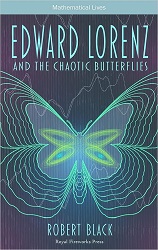
 Edward Lorenz and the Chaotic Butterflies
Edward Lorenz and the Chaotic ButterfliesRoyal Fireworks Press, 2022. 127 pages.
Review written January 8, 2022, from my own copy.
Edward Lorenz and the Chaotic Butterflies is a short but thorough biography of one of the founders of Chaos Theory.
Edward Lorenz got interested in meteorology because that happened to be where the U.S. War Department could use his mathematical skills when World War I started.
The book explains how the science of meteorology was developing as computers were developing. And when they tried to model the math of weather forecasting, it was so complex that those two things went together. In fact, because Edward Lorenz had a desk-sized computer in his office at M.I.T., he was able to notice things that other researchers had a harder time studying.
They talk about his initial discovery. He wanted the computer to repeat some calculations but go farther, so he started by typing in the results from already-calculated numbers. But the results the second time through were completely different. He realized that was due to a rounding error -- he hadn't printed out all decimal places of the solutions, so he was actually starting with slightly different numbers.
But why did slightly different starting numbers make a huge difference in results?
I like the way the book describes the equations he used as both unpredictable and stable. The equations are relatively simple, but the results vary wildly. The book even shows how you can do the same thing with a home computer (much smaller than a desk) and an Excel spreadsheet.
I did gloss over some of the equations, but I got the idea of how it all works, and I think students can do the same as me or dive in deeper if they want to know more.
A quick biography of a notable mathematician who started a whole new field of study and showed that not all of reality is linear and predictable.
